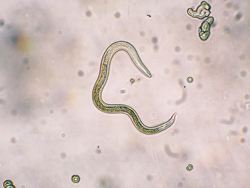Parasite antigens for diabetes treatment
Diabetes is a group of chronic disorders associated with high blood glucose levels. There are two types of diabetes, type 1 — an autoimmune disorder caused by the destruction of the insulin-producing pancreatic beta cells and type 2 — caused by insulin resistance. Insulin resistance is the outcome of adipose tissue inflammation and cellular composition alterations. Accumulating evidence indicates that the increase in diabetes prevalence over the years could be due to environmental factors. One such factor could be the loss of parasitic worm (helminth) infections in developed countries. Parasitic helminths are potent modulators of the host immune system and they also affect responses to other antigens. Scientists believe that the absence of helminth infections could suppress responses associated with preventing insulin resistance development. To investigate this phenomenon, the EU-funded HELMINTH & DIABETES (Helminth-induced regulatory mechanisms that prevent the onset of diabetes) project used the non-obese diabetic (NOD) mouse model for type 1 diabetes. The aim was to identify the helminth-induced regulatory mechanisms that mediate protection against diabetes onset. Results indicated that infection with the nematode Litomosoides sigmodontis prevented the onset of type 1 diabetes in these animals. Mechanistic insight showed that it depended on the anti-inflammatory cytokine TGF-b but was independent of regulatory T cell responses. Importantly, researchers showed that administration of the nematode antigen LsAg with pro-insulin therapy at a point where animals had developed insulitis prevented diabetes onset. This combinatorial treatment increased regulatory T cells and maintained pancreatic islet physiology and function. Similar results were seen in diet-induced obese mice where nematode antigens improved glucose tolerance. Intriguingly the cellular composition within the adipose tissue resembled that of lean mice and gene expression analysis further supported a molecular switch to insulin sensitivity. Furthermore, administrations of helminth antigens increased energy expenditure via the browning of subcutaneous adipose tissue. The therapies proposed during the HELMINTH & DIABETES study have important clinical consequences as they could delay the onset or progression of diabetes and ameliorate associated pathology.







